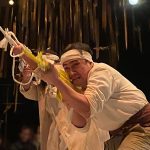One of the biggest challenges to adapting a literary piece that has occupied such a sacred place in the pantheon of western theatrical classics is doing so organically. The adaptation should be true to the original, and it cannot diminish the emotional resonance in the reframing of the story in another context in order for it to succeed. This is why there are very few successful adaptations of western literature reframed in a local, Filipino, context. Read on for our review of Katsuri staged by Tanghalang Pilipino.
Upon first glance, it’s a brilliant idea to adapt John Steinbeck’s classic story “Of Mice and Men”, and give it a local twist. The setting, and the working conditions of America’s migrant ranch workers during the Great Depression, after all, is very similar to the current plight of our very own seasonal sugar cane farmers, or as they are more commonly known: Sacadas. Indeed it is almost uncanny how perfectly the original and the adaptation would have lined up, though it would not have been easy to translate not just the words that build the world of the play, but the reconciliation of the cultural nuances that would make sense within that world.

That idea, as daunting as it must have been, gave birth to “Katsuri”, a brave adaptation by Bibeth Orteza, under the direction of Carlos Siguion-Reyna. It tells the story of George (Marco Viaña) and Toto (Jonathan Tadioan), a pair of sacadas who, after an unfortunate incident in Hacienda Luisita, found themselves in Negros Occidental in the employ of a new Hacienda where they are tasked to harvest sugarcane. Toto, a freakishly strong man with a mental disability serves as the story’s moral default: a sort of dimwit innocent. George, slight of build, but the quick-witted of the two, serves as Toto’s companion and carer. They share a dream of owning and running their own farm: one that is explained in great effective detail by an utterly sympathetic Viaña, for the benefit of the childlike Tadioan. The story, as told by six scenes in two acts, follows the pair through their days at the farm, and their interactions with the people who make up the small community of people living off of the land.

The production in the CCP’s Tanghalang Huseng Batute welcomes you into this world. Walking into the venue transports you to a gritty, almost mangy world that is at times desolate and claustrophobic. Ohm David (Set Design) and Dennis Marasigan (Lighting Design) manage to create an environment that folds in on itself and offers the audience a variety of scenes that serve the actors well. It is in this space that the story descends into a deep exploration of the universal themes of loneliness and that human desire to connect with another. The most poignant moments of the play happen in the way each character is driven to varying degrees of desperation, and how they express their frustration, punctuated with humor when confronted by the incontrovertible knowledge of their own brokenness. The bleakness and hopelessness of these lives are echoed in the desperate conditions of their often-deadly occupation.

The play is also framed within the current conflict faced by Filipino farmers and workers. The statement the play wants to convey is painted in broad strokes during the transitions, showing short unsettling moments of violence that pervade the atmosphere of the theater. The play’s ultimate and tragic end speaks to how we have become most comfortable in how things are instead of how things ought to be: that in our pursuit of personal gain, we lose sight of what matters, and what gives our lives meaning. This production ramps up the stakes effectively and makes for fresh, truly riveting, and oddly touching drama.
Tanghalang Pilipino’s “Katsuri” runs from October 4 to 27, at the CCP Tanghalang Huseng Batute. Tickets are available at the CCP Box Office, Ticket2Me, Bliimo and all Ticketworld outlets.
Click here for more stories like “Katsuri by Tanghalang Pilipino: A Review”. Make sure to follow and subscribe to our social media accounts: Facebook, YouTube, Instagram, and Twitter.






















